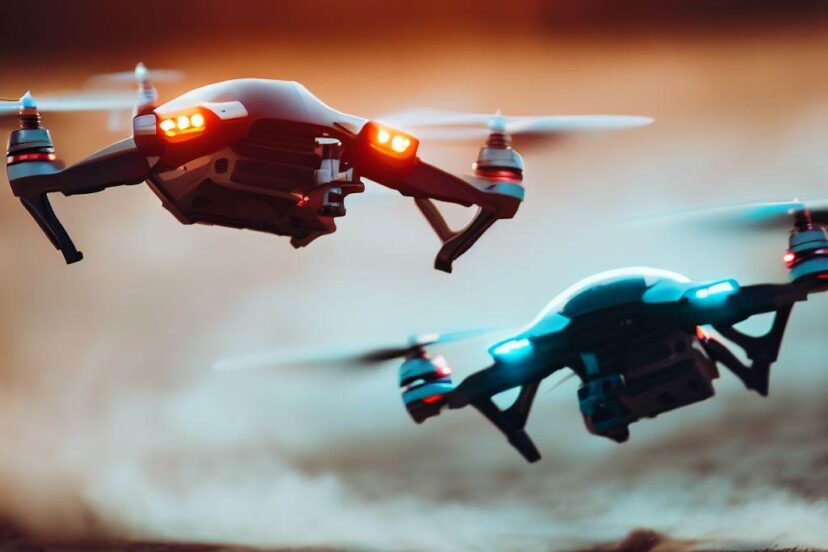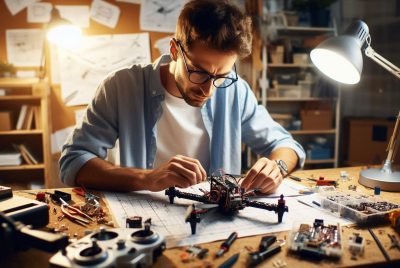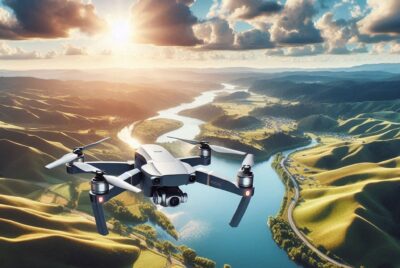Race Drones: Unleashing the Thrill of High-Speed Skies
*We may earn a commission for purchases made using our links. Please see our disclosure to learn more.
Race Drones: Unveiling the Thrill of High-Speed UAV Competitions
Racing drones, also known as FPV (First Person View) drones, are designed to offer a unique flying experience that captures the thrill of speed and agility. Designed for both competitive racing and freestyle flying, these race drones provide an immersive experience as if I’m sitting in the cockpit, piloting through complex courses and obstacles. With advancements in RC (radio control) technology, the performance of racing drones has significantly improved, leading to faster and more intense competitions.

My experience with racing drones has taught me that they excel in maneuverability, capable of making sharp turns and quick dives that traditional drones cannot achieve. The emphasis is not just on speed but also on the craft’s ability to navigate through challenging environments with precision. Flight times vary among models, but racing drones are generally built for short, high-intensity sessions rather than prolonged aerial photography flights.
The adrenaline-pumping action isn’t restricted to outdoor spaces; many enthusiasts, including myself, take pleasure in indoor racing that tests reflexes and control. Whether it’s dodging flag gates or weaving through improvised courses at home, the versatility of racing drones is evident. FPV technology has been a game-changer, offering live video feed directly to my goggles or monitor, allowing for a truly engaged racing experience.
Understanding Race Drones
In this section, I’ll take you through the essentials of FPV racing drones, focusing primarily on their definition and the key components that make up these high-speed, competitive machines.
Defining FPV Racing
First-Person View (FPV) racing involves piloting drones through courses as fast as possible, all while experiencing the flight through a camera mounted on the drone. This unique perspective is what sets FPV drone racing apart; it’s as if I, the pilot, am seated within the drone itself, navigating through obstacles with agility and precision.
Racing Drone Components
Quadcopter Frames: Typically, I’ll consider the structure known as the frame, which not only supports all components but also significantly influences the drone’s durability. A good frame is both lightweight and resilient, allowing it to withstand crashes.
Motors and Propellers: These are the heart of any racing drone, providing the thrust needed to maneuver through race courses. More powerful motors often yield better acceleration and top speeds, while the propellers affect the balance, thrust, and agility.
| Component | Functionality |
| Motors | Convert electrical energy into mechanical energy, generating thrust. |
| Propellers | Push against the air to create lift and allow for intricate maneuvers. |
Batteries: I can’t overlook the importance of batteries; they are the lifeblood of FPV drones. Strong batteries improve flight time and performance, but their weight is a trade-off that needs careful consideration.
Camera Quality and Transmission: High-resolution cameras with exceptional transmission systems are critical. They ensure the visual feed I rely on for piloting is both clear and responsive, with minimal latency.
RTF and BNF: Ready-To-Fly (RTF) drones come complete with all necessary components, perfect for those who prefer a pre-assembled set. Bind-N-Fly (BNF) models require a compatible transmitter and sometimes additional components, offering a balance between custom-built and ready-made.
When building a custom drone, I focus on combining these elements to create a machine that fits my precise racing style and requirements. Durability, flight time, and performance are factors I weigh carefully, aiming to build a racing drone that stands out in competitions.
Choosing Your Race Drones

When selecting a racing drone, it’s essential to weigh the pros and cons between ready-made options and custom-built assemblies. As well as to consider the cost, size, and brand that best suits your racing ambitions.
Ready-to-Fly vs Build Your Own
Ready-to-Fly (RTF) Drones:
- Convenience: RTF drones like the DJI FPV come out of the box complete and ready to fly, which is ideal for those who prefer to hit the racing circuits right away.
- Cost: Typically, RTF drones may offer more value initially. For example, the EMAX Tinyhawk 2 is renowned for its balance of price and performance.
Build Your Own Drones:
- Customization: Choosing to build your own drone allows for complete customization of parts like motors and Electronic Speed Controllers (ESCs). It gives me the ability to tailor the drone to the specific needs of different race courses.
- Knowledge Gain: Building a drone from scratch teaches me the intricacies of drone mechanics and electronics, which is invaluable for troubleshooting during race events.
Factors to Consider: Price, Size, and Brand
| Factor | Details |
| Price | While cost is a significant factor, I always consider the long-term value, like including accessories or free shipping, offered by brands like iFlight. |
| Size | The size impacts maneuverability; a compact and lightweight drone is often preferable for racing. |
| Brand | DJI and EMAX are respected brands; DJI is known for advanced technology, while EMAX engages the community with sturdy, entry-level options. |
I look for drones that strike a balance between the three factors, ensuring that the final purchase is a cost-effective investment into my racing potential. When evaluating brands, I always research their track record in drone racing communities and look for any brand-exclusive features they might offer.
Technical Aspects of Drone Racing

In the competitive realm of drone racing, the technological components, like camera systems and flight control, play critical roles in a pilot’s performance.
Camera and Transmission Technology
FPV Goggles: For an immersed racing experience, pilots use FPV (First Person View) goggles. The DJI FPV goggles, for instance, are highly regarded for their quality. With a high-resolution display, I experience the race through the drone’s eyes, which necessitates a camera system with good image quality.
Camera Resolution: Modern racing drones employ cameras with varying resolutions, measured in TVL (Television Lines). While this might seem less than what is found in standard cameras, in drone racing, TVL is optimized for speed rather than sheer image quality.
- Analog vs Digital: Traditional systems have used analog transmission for its lower cost and wide availability. However, digital systems, like the DJI O3 Air Unit, are becoming more prevalent due to their crisper image and less susceptibility to interference.
- Low-Latency Transmission: Regardless of analog or digital, the key is low-latency transmission, crucial for high-speed maneuvers where every millisecond counts. My experience confirms that digital systems often offer more stable and reliable low-latency feeds than analog.
Race Drones: Flight Dynamics and Control
Transmitters: I control the drone using a transmitter, which should have a wide control distance to maintain signal strength throughout the race. Range is often determined by frequency bands and power output of the transmitter.
- Control Distance and Interference: Generally, higher frequencies offer crisp control but might reduce the control distance and are more susceptible to interference. To combat this, I choose frequencies carefully and sometimes rely on redundancy systems.
- Flight Time and Battery: Concerning flight time, most drones I race with last between 4 to 6 minutes, heavily dependent on the size and capacity of the battery as well as the racing style.
- GPS and Wind Resistance: While GPS is often not used in races due to weight and speed considerations. Mastering wind resistance through drone design and flying technique can be essential, especially when facing outdoor elements.
My understanding and adaptation to the technical nuances of my racing drones have proven indispensable for optimizing my in-race performance.
Race Drones: Safety and Regulations

Drone racing brings with it the thrill of speed and the challenge of precise control. Ensuring the safe operation of race drones is paramount, not only for the pilots and the integrity of the sport but also for bystandal safety. I’ll discuss the key regulations and safety measures that are necessary for responsible drone racing.
FAA Guidelines and Part 107
To legally race drones in the United States, I must adhere to the Federal Aviation Administration (FAA) guidelines. According to Part 107, the set of regulations for unmanned aerial vehicles (UAVs), I need to ensure the following:
- Obtain FAA Certification: Before I can pilot a drone for racing, I am required to pass an aeronautical knowledge test to obtain a Remote Pilot Certificate.
- Flight Restrictions: It is mandatory for me to fly the drone within visual line-of-sight and avoid restricted airspace unless I have explicit authorization.
Ensuring Safety During Races
When participating in drone races, I prioritize safety through:
- Pre-Flight Checks:
- Inspect the drone’s frame, propellers, motors, and electronics for damage.
- Check for obstacle sensing capabilities to prevent collisions.
- Safety Equipment:
- I use protection guards on my drone to minimize the risk of damage or injury.
- For the audience, implementing an audience mode ensures they can watch the race safely.
- Education and Practice:
- Regular practice on a simulator helps me to hone my skills in a controlled environment.
- Continuous education on evolving regulations and safety practices keeps me informed and compliant.
By making sure I have a strong understanding of both the FAA regulations and the importance of implementing safety measures before, during, and after races. Then I guarantee a secure and enjoyable experience not only for myself but for other pilots and spectators alike.
Race Drones: Advancing Your Racing Skills

In the dynamic world of drone racing, enhancing your skill set is essential for both competitiveness and enjoyment. Focused practice routines and participation in organized leagues can lead to tangible improvements in control and speed.
Race Drones: Practice Routines and Flight Simulators
I advocate the use of flight simulators as a risk-free environment to refine skills. Simulators like VelociDrone and Liftoff replicate the physics of drone flight, allowing for countless hours of practice without the wear and tear on your equipment. Here’s how I incorporate them into my training:
- Dedicated Practice Sessions: I schedule regular sessions, focusing on different flight techniques or racing scenarios.
- Track Familiarization: Before attempting a new course, I use simulators to learn its layout, which improves my reaction time in real races.
- Skill Drills: I work on specific maneuvers like hairpin turns or slalom flights to build muscle memory.
Simulators are complemented by actual flight time. With my race drone, particularly models like the ARRIS X-Speed 280 V2 or a custom build with a carbon fiber frame, I ensure a balance between speed and stability. I am meticulous with battery management; high-capacity batteries extend flight time but 1S batteries are lighter and can offer more agility for short bursts.
Joining Drone Racing Leagues
Joining a league like MultiGP Drone Racing League is a significant step in my racing journey. It provides structured competition and community support. Here are my experiences:
- Structured Competitions: Racing in a league offers regular events and a framework to gauge my progress against other pilots.
- Community Learning: I absorb knowledge from more experienced pilots, gaining insights on how to tune my drone for optimal performance.
While drones like the DJI FPV combo and DJI Air 2S may be marketed for their cinematography capabilities. In a racing context, they can sometimes lack the customizability and raw speed—often topping 100 mph—of dedicated racing drones. Nevertheless, the DJI FPV can provide an accessible entry point with features like free shipping appealing to beginners. I weigh the pros and cons carefully when choosing my equipment, considering factors like durability and upgradability.
FAQs About Race Drones

1. What are the essential components of an FPV race drone kit?
My FPV racing drone kit typically includes the drone itself, a controller, FPV goggles for a real-time view from the drone’s perspective, batteries, a charger, and sometimes extra propellers and parts for repair.
2. What is the typical speed range for competitive racing drones?
Competitive racing drones are designed for speed and can typically fly between 60 to 100 miles per hour, depending on the model and modifications.
3. How do I get started in drone racing?
To get started in drone racing, I would first invest in a beginner-friendly racing drone. Then learn to pilot it proficiently, and then find a local racing club or online community to join races and practice.
4. Are there any regulations or permits required for FPV drone racing?
Yes, FPV drone racing is subject to regulations. In the United States, drones over 0.55 lbs require FAA registration, and pilots must adhere to the rules, such as maintaining line-of-sight or obtaining Part 107 certification if racing for a prize or commercially.
5. What factors should be considered when choosing goggles for FPV drone racing?
When choosing goggles for FPV drone racing, I examine the resolution and field of view for the best visual experience. Then I ensure they are compatible with my drone’s camera system, and check for comfort and adjustability.




